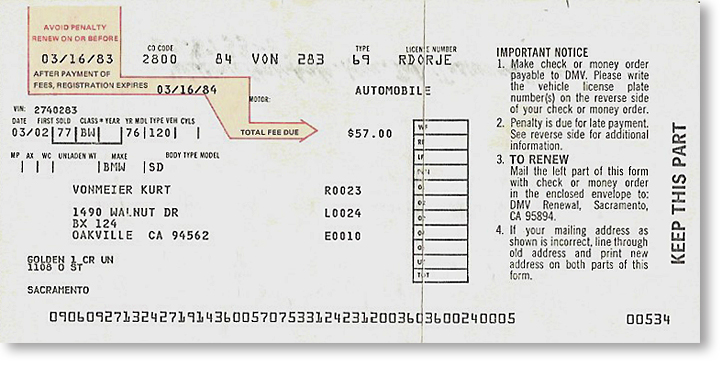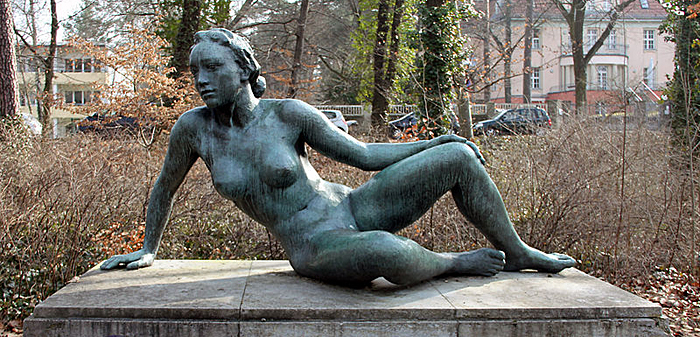To engage with Kurt was to enter his world, a playful one filled with multicultural richness and soaring flights of imagination. In Kurt's fiction, one often finds him in one disguise or another; enjoying many emanations was his theatrical brand of self-referential paradox. In the text, he lays this out plainly:
"The realities of life end death, consciousness and physical manifestation, the nameable and unnameable Tao--these choice dichotomies, and the whole of Boolean algebra and binary logic, Leibnitz and the I Ching, the good Doctor wondered at and lived through as a trade-off between Interaction and Equilibrium in a comingled universe of reality and dream."
This story contains many characters later incorporated into Omasters, and this episode--filled with fine food, good coffee, liquor, hashish, cocaine and sex--highlights Kurt's sometimes all-consuming style of sensual energy.
A Letter to Richard Graff of The American Institute of Wine and Food
In this letter from 1983, Kurt addresses the remarkable attention received by food and wine in California. "The most civilized conversation these days, with incisive intelligence, a sense of the poetic and theatrical, delicate perceptions, and robust innovations, is all about food (not music, not painting, not architecture)." Yet, as with all things, Kurt was looking at the topic of food at a deeper level, concerned about the loss of indigenous traditional cultures and starving nations. "We live in a time when many of the surviving traditional cultures are threatened with extinction, and their lessons must be recorded or lost." Never one to shy away from difficult matters, his letter is polite while pointed. No reply has been found in his archives.
2wallymail - June 15, 1996
Here's an email Kurt composed to Cliff (Walter) Barney in 1996, in response to an email Cliff sent Kurt in May (delivered in printed form to Kurt in June). The original email noted (and the package contained) the cover of TIME magazine, featuring an article - "Can Machines Think?" Both Kurt and Cliff had steeped themselves in the cybernetic theories of Heinz von Foerster, and the writings of Warren McCulloch. Kurt's reply is typically wide-ranging, well-informed and entertaining, and reveals his frustrations with the emerging use of email and "spellcheck." Accordingly, he notes inaccuracies and inconsistencies in spelling in several sources of information. "Jene LaRue used to say that while spelling rules--the rightness of orthography--were conventional, it was most important (deepest, oldest, most prior) to spell correctly the names of the gods and presumably, in hierarchical order, those of the demi-gods, heroes, daimons, distinguished colleagues, scientists, artists, authors because they are the notational forms that enjoin (or sustain) being invoked, so one had best get it right, or at least as right as possible." He also carefully examines the magazine cover, noting the number of cogs on the gear wheels.
On Audio: It's All About Time - An Art and Mythology Lecture 1971
In this recording of a lecture at Sacramento State University from 1971, Kurt holds the attention of his class with an engaging, impromptu presentation about time. Moving seamlessly through topics ranging from language, dogs, The Great Beast, Pan, Shiva, music and dancing, Kurt constructs an inventive and entertaining presentation. The lecture runs just under a half hour in length.
Norman Akaya and Jose Que's Blue Beamer
Herewith another installment of the story of Norman Akaya and his uncle Jose Que (Kurt's alter ego). Drawing upon Kurt's commute to Sacramento State to lecture on Tuesdays and Thursdays in his blue BMW (license plate RDORJE) in 1982, this segment slides seamlessly between fiction and fact, like tires slipping on a rain-slicked road. "But it was on the road that Jose Que worked for his money. There, emeritus or not, his actions and those of all the other travelers entailed consequences in the immediate. Jose rode what was once the Ultimate Driving Machine, lightweight, responsive, amply powered, well-braked, the classic 2002; with some internal modifications, because a logical sixty miles an hour meant a nice harmonic of 3600 r.p.m."
New Zealand and the Arts of the South Pacific
Many of us today have experienced New Zealand as the spectacular setting for Hollywood movies. Kurt spent two years teaching at the University of Auckland in New Zealand in the early 1960s, and it left an indelible impression on him. He continued to follow "The Blacks" rugby team for the rest of his life. His two years were not without controversy, however; his newspaper article criticizing the new fine arts building at the University's Elam School of Fine Arts made him enemies, and he returned to the United States where he taught for one year at Princeton before moving on to UCLA. This article, prepared for a talk he gave while in New Zealand, probably raised a few eyebrows as well. Kurt takes it upon himself to make a series of critical suggestions to insure that New Zealand's native Maori art remains accessible and ways to insure that New Zealand's art history program develops properly as an academic discipline.
Meierbücher
As early as 1965 Kurt was already conceptualizing a book about his life, as these pages from one of his notebooks indicate. At the time he'd just turned thirty years old, a rising-star-assistant-professor at UCLA and beginning to write furiously in magazines about the world of fine art and art history. In a sense, his life had barely begun; many additional chapters had yet to be recorded. Though his penchant for self-documentation was well established, Kurt's Meierbücher never got written. That task was left to others, as this website attests.
Kurt also made a list of books he planned to write; that list is shown as well. He completed one and wrote others he never imagined.
Homage to All Teachers - A Lecture
"All culture is whole, it’s all one. It gets fucked up and misunderstood, but you can usually spot that because you have a paradigm. You can see how it relates." So states Kurt in this extraordinary lecture (circa 1973) in which he demonstrates rather than explains this premise, adopting styles of teaching from shock-jock to stand-up to hold the attention of his students. A tour de force, this lecture is also a glimpse into the wholeness of Kurt's mind, a rich, cross-cultural web of references and associations reflecting the actuality of how Kurt experienced each and every moment. Kurt's close friend and collaborator Clifford Barney, who generously transcribed the lecture, provides a prologue.
On Audio: Horseshit vs. Bullshit - An Art History Lecture, 1968
Comparing horseshit with bullshit is how Kurt begins this Art History lecture, recorded sometime around 1968. He is at his entertaining, informative best--funny, insightful, challenging and relevant to the times. Reflecting on so-called "primitive culture", Kurt calls into question many of our civilized values, quoting anthropologist Claude Levi Strauss in the process and invoking the likes of Buckminster Fuller, Carlos Castaneda and Marshall McLuhan. Using examples from his collection of Navajo blankets (example above), he vividly connects the psychedelic revolution with the ancient peyote rituals of Pueblo Culture, and warns of the ways civilization is destroying the earth.
Death of the Masterpiece
Here's a short, hand-written essay by Kurt which appears to have been drafted while in attendance at or not long after his graduation from Princeton University. As such, it's as an early gesture in his direction of art criticism, an activity which would occupy his talents as an art historian in various publications for the rest of the decade. His theme anticipates the thrust of his later, more sophisticated, articles-- he writes, "...in approaching the 20th century, it becomes increasingly difficult to single out works of art as “masterpieces”...New standards of selection should be introduced which enable us to consider the complete oeuvre of a painter as an entity." No typewritten version of this essay has been found in his archives.
The Root of Omasters: Laws of Form
Collaborating with Cliff Barney, Kurt conceptualized a book proposing to expound upon Brown's Laws of Form by actually performing Brown's calculus; "to show how, by examining the structure of Spencer Brown's calculus, which is to say its language and symbols and formal relations of its parts, we may, by uncovering the form of the form, see and intuit the relation of form to content and the way in which all systems reflect themselves in each other." What began as a scholarly exercise evolved instead into the fictional Omasters, its oddball characters and settings presenting various archetypes postulated by Brown and action within differing but simultaneous realms of time.
Which Monkey Ate the Peaches?
Kurt rarely wrote out his presentations in advance, preferring to prepare notes from which he could speak extemporaneously. He would either outline a topic or simply prepare a precis upon which he would then elaborate. Such is this brief set of "notes" Kurt prepared for a joint presentation with Claudio Naranjo (pictured at right) for a talk at the Institute of Asian Studies in April, 1977. Claudio Naranjo, a Chilean-born mystic, scholar, psychiatrist and psychonaut shared many qualities in common with Kurt; he too was a student of Oscar Ichazo, the founder of the Arica School.
Commentary on Jene La Rue's "The Meanings of Mythology"
Kurt's close friend and fellow Princetonian Jene La Rue went on to become an Assistant Professor of Classics at State University College at Buffalo, New York at the same time Kurt was an Assistant Professor of Art History at UCLA in the mid-sixties. While at Buffalo, Jene wrote a lengthy paper entitled "The Meanings of Mythology" (to read it, CLICK HERE) which both reiterated many of Kurt's interests, and also prompted Kurt's own reflections on the subject, which he shared with Jene later on in the early seventies in this commentary. Kurt and Jene, together with Jene's childhood friend Tom Genelli, together went on to create and operate The Diamond Sutra Restaurant in San Francisco in 1970. Jene and Kurt remained close friends until Jene's untimely death from cancer.
Buddy Meier's Dream
Kurt rarely wrote about his own life in a straight-forward way, preferring to place biographical information within a fictional context. His theatrics and bluster masked a deep sensitivity, and whatever hurt or trauma he suffered slipped readily into fantastic narratives filled with imaginary characters, some of whom he later incorporated into Omasters. This fictional piece, however, features Buddy Meier, and the resonance of his early life, including his mother, her apple pie, and the spectre of his father, who died when Kurt was only eleven years old. "Miss your daddy, do you Buddy boy? Well he is a logger in the forest of night, logging a long cruise like a wallowing Walloon, your lowland version of a Flying Dutchman, who may now be wending the tortuous way home to the Rome of our beautiful apple pie perennial, cooling atop the oven...," he writes, in the voice of his mother. One part a Joycean Alice in Wonderland, another an excursus on The Void, and yet another pure Buddy Meier.
Kurt's Letter from India - 1984
In this 1984 letter to Cliff Barney while Kurt and his girlfriend Victoria were in Varansi, India, we get a glimpse not only of Kurt's fine handwriting (nary a crossed-out word to be found!) but also how he felt about India's social conditions. "The poor burn patties made from straw & cow dung (goat, dog, donkey) plastered in discs to dry on walls exposed to the sun. Of course, this is ecologically corrupt." And, "The leprous extremities. The iodine deficiency, so simple to prevent with iodized salt." His travel plans included Nepal next; he'd traveled to Thailand before India.
Georg Kolbe - Kurt's Doctoral Dissertation
Kurt submitted his doctoral dissertation on the German sculptor Georg Kolbe (1877-1947) to the Department of Art and Archaeology at Princeton University in 1965. Combined, the text, notes and illustrations numbered over 800 pages, far too much to upload to this website. However, the Introduction has been scanned and converted to digital text (and a few images added) so that it can be included with the rest of Kurt's archives.
Capsules from an Excursus on 1111
As if he were warming up for writing his 350,000 word opus A Ball of Twine, Kurt wrote reams in 1982, including this segment from an unnamed manuscript. In it we find many of the topics which dominated Kurt's thoughts, including mathematics, word etymology, Segre's figure, Finnegans Wake, Tibetan Buddhism and late-night television. "For whatever it's worth, at 11:32 p.m. (which of course is 23:32, a palindromic number) Johnny would finally quiet down the applause in Burbank while Jackie would be making his appearance on the set in "The Honeymooners" in the East (Carson and Gleason, respectively)."
More on Twine
This single page of text--unnumbered--was floating amid Kurt's archived papers, like an abandoned ship. Undoubtedly struck by inspiration, Kurt characteristically connects otherwise disparate topics, deftly weaving between Melville, twine, salt and Marcel Duchamp. "...and isn't Queegueg's character understood by some critics as a token of ambivalent sexuality, the shaman as androgyne?" he writes. "So too Marcel Duchamp/Rrose Selavy, under the guise of kryptofemininity, as in Man Rays' famous portrait of the Drag Quean."
Rock n' Roll 1964: Observations and Events
As part of his preparation for his History of Rock and Roll, Kurt compiled observations and a record of events for each of the years 1954-1966, the period he felt encompassed the beginning and the end of the "rock and roll" phenomenon. This document (typed on a manual typewriter) covers 1964, the year Kurt felt that teenage sophistication had matured to the point of questioning the establishment and greater awareness of the world. Though in the form of notes, his record provides a coherent recollection of a year of dynamic change in the history of rock and roll.
On Audio: Lecture on Magic Mushrooms and Shamanism - 1969
After his contract at UCLA was not renewed, Kurt remained teaching in Los Angeles for a while at California State University. Despite the controversy surrounding his teaching methods at UCLA, Kurt continued to teach in unconventional ways. This lecture includes his reading from Gordon Wasson's seminal text on mushrooms, recordings of a woman singing shamanistic chants, a couple of cuts from a Beatles' album and Kurt's own reflections on the topic. All this was, in Kurt's words, to help create a simulated "psychedelic trip" for his students. The recording runs just under 1.5 hours, and takes a minute to load.




































